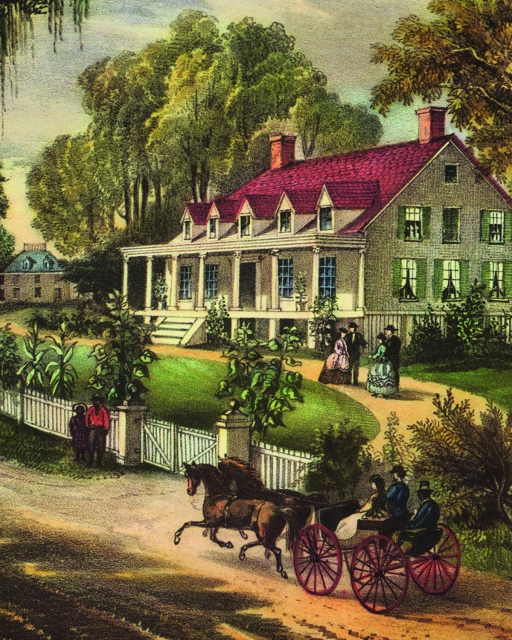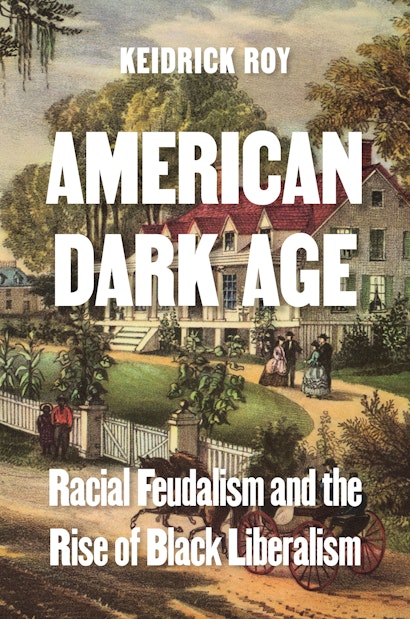What did it mean to be an enlightened “liberal” in the United States before the twentieth century? What’s race got to do with it?
Since the nation’s founding, prominent thinkers associated with the early American liberal tradition—from Thomas Jefferson to Frederick Douglass—debated the efficacy of liberal ideas such as individual rights, human equality, moral universalism, and progress. They did not necessarily endorse “liberalism” in the sense now commonly equated with atomistic individualism and unfettered free markets that ignore the collective good. Instead, they frequently contrasted their liberal commitments with contemptuous characterizations of feudalism. My forthcoming book, American Dark Age, reconstructs their view of liberal ideas by shedding light on how they understood feudalism—its ideological antithesis.
During the late 1700s, the founding generation was abuzz with condemnations of “feudalism” and “feudal law.” Luminaries such as Thomas Jefferson, John Adams, Noah Webster, and Thomas Paine repudiated purported atavisms of feudalism in Europe and the fledgling United States. Indeed, Jefferson gained political prominence in the Revolutionary era as the author of a 1774 document that conspicuously criticized the “feudal tenures,” “feudal burthens,” and “family of princes” that dominated Britain’s past as he contextualized the political overreaches of King George III and the British Parliament. Shortly after America declared independence in 1776, Jefferson authored economic legislation in the Virginia House of Delegates against the practices of primogeniture and entail that—in his view—abolished “the feudal and unnatural distinctions” still present in Virginia. Jefferson praised this and other early laws he wrote as “forming a system by which every fiber would be eradicated of ancient or future aristocracy and a foundation laid for a government truly republican.”
Despite Jefferson’s celebratory claims about removing the final vestiges of feudalism, African Americans continued to face artificial hierarchies preserved by slavery in the South and prejudice in the North. In researching their reactions to these conditions, I found that many prominent Black abolitionists—in line with the patriots of the founding era—drew on feudalistic metaphors to characterize their conditions of subjection. For them, notions of medieval feudalism (such as “vassalage,” “serfdom,” “homage,” “crusades,” and “dark ages”) often signaled one of three related concepts: (1) artificial hierarchies, (2) arbitrary violations of natural rights and freedoms outlined in the Declaration of Independence and codified in the U.S. Constitution, and (3) abuses of political power perpetuated by a tyrannical governing authority.
However, unlike Jefferson and the other founders, Black Americans across the nineteenth century described their perception of feudal vestiges on U.S. soil in relation to racial hierarchy rooted in notions of paternalism, “mutual” obligations, and natural pecking orders. The language they used and the illiberal ideology it unmasked represent what I call racial feudalism. In 1827, for example, a Black minister named Nathaniel Paul questioned the integrity of America’s founding ideas while there were “no less than fifteen hundred thousand human beings still in a state of unconditional vassalage.” (A “vassal” is a subordinate tenant in the feudal system that owes homage and allegiance to the superior lord.) George M. Horton, in an 1845 poem entitled “The Division of an Estate,” similarly portrays enslaved people tending a sprawling plantation under foreclosure as “poor vassals.” Two years later, the fugitive slave and author of the first Black American novel, William Wells Brown, wondered aloud: “Shall the American people be behind the people of the Old World? Shall they be behind those who are represented as almost living in the dark ages?” For him, racial slavery “has given the serfs of the Old World an opportunity of branding the American people as the most tyrannical people upon God’s footstool.” Likewise, Frederick Douglass compared the conditions Black people faced in the United States under the 1850 Fugitive Slave Law to “all the monarchies and despotisms of the old world,” calling the North a “mere cringing vassal of the South.” He also conspicuously likened his Maryland plantation to “what the baronial domains were during the Middle Ages in Europe.”
Other antebellum Black Americans equated the U.S. military’s treatment of native peoples and Mexicans to medieval campaigns. In 1837, Hosea Easton, for example, resoundingly condemned “the late unholy war with the Indians” and the “wicked crusade against the peace of Mexico.” Along these lines, African American abolitionist Martin Delany excoriated future president Zachary Taylor of “Indian-murder, bloodhound, and Mexican-slaughter notoriety” in an 1849 letter to Frederick Douglass. Denouncing Taylor’s supporters, he writes, “The extent to which the American people carry this glorification of military crusaders is beyond a parallel… . The extent to which this homage is carried ceases to be respectful since it is neither kind nor complimentary, but like the homage of the serf to the noble or the vassal to his lord, it is ludicrous.”
Contrary to Black abolitionists’ damning critiques of feudalism and its associated concepts during the first half of the nineteenth century, many proslavery thinkers from that period celebrated what historian and sociologist W. E. B. Du Bois assailed as “American feudalism.” From the halls of Congress and state legislatures to the lecture stages in colleges and the pages of agricultural journals, they lobbied for legislation and supported institutions that would attempt to re-create—in law and culture—a society that mirrored their positive visions of a feudal past, with Black people now serving as the peasants in the lowest caste. They consciously deployed the nostalgic language of feudalism as a political smokescreen to obscure their moves to consolidate the social, political, and economic power that would sustain their elevated social position and collective racial ascendancy. In the halls of Congress, for example, U.S. Representative James Henry Hammond bellowed that American slavery retained the “advantages” of “the aristocracy of the old world.” In 1860, proslavery supporter J. Quitman Moore wrote that “Southern society revived the genius of medieval civilization” and even surpassed it because of new racial science.
Against these forces of racial feudalism, many Black Americans worked to renovate and expand the foundation of liberal ideas in the United States. Their framework, among other things, opposed the illiberal expulsion of Black people from America (a process known as “colonization”), favored reform over revolution (except for the abolition of slavery), maintained an identity-aware as opposed to an identity-blind or identity-driven ethical disposition, and emphasized national political transformation through individual and collective moral improvement. Altogether, antebellum Black liberals nurtured a spirit of cautious optimism as they worked to initiate new ways of knowing and being “American” that remain instructive today.
In the final chapter of American Dark Age, entitled “Why am I Black?”, I bring the Black American liberal framework to bear on today’s political scene. In doing so, I critique what I call “identity-blind” and “identity-driven” positions on liberalism and, drawing on Frederick Douglass, champion identity awareness. An identity-blind approach—which holds that racial or gender considerations should have no place in public policy decisions—can ignore or minimize historical forces that distinctively shape the experiences of people in particular groups. An identity-driven approach—which sees foregrounding the needs of one’s own identity group as central to effective policy creation—tends to view the world through a lens that can obscure the importance of coalitions that cut across multiple group experiences. The identity-aware approach recognizes the impact of historical forces on group identity and finds ways to link individuals to broad-based alliances. It seeks to create space for discussing differences without valorizing or trivializing group identity in ways that tend to oversimplify its manifest content.
All told, American Dark Age highlights the contributions of early African American liberals to the American political tradition, where their status as equal contributors has long been overlooked. Moreover, it provides readers with a distinctive constellation of thinkers actively involved in creating political change through their criticism of the vestiges of feudalism as they worked to root out the causes of racial subordination and inequality through political processes grounded in the liberal principles that inspired America’s founding documents. They all recognized that while the arc of the moral universe is long, it did not necessarily bend toward justice without applying the pressure of political appeals and fostering public dialogue across stark lines of division. While much can be learned from what historian and political theorist Cedric Robinson labeled the “Black Radical Tradition,” American Dark Age spotlights an early Black American Enlightenment tradition that tested, reformed, and ultimately embraced the promise of liberal ideas.
Keidrick Roy is a Junior Fellow at the Harvard Society of Fellows. In 2025, he will be Assistant Professor of Government at Dartmouth College. He has received national attention through media outlets such as CBS News Sunday Morning and the Chicago Review of Books and appears in the HBO documentary Frederick Douglass: In Five Speeches. He has curated two major exhibitions at the American Writers Museum in Chicago on Black American figures, including Frederick Douglass, Ida B. Wells, and Ralph Ellison.

